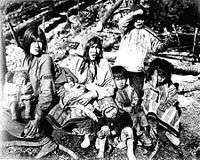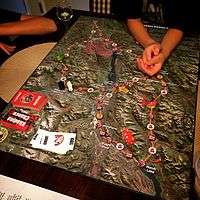Indigenous peoples of Yukon
The indigenous peoples of Yukon are an ethnic group which occupied the territory now known as Yukon Territory prior to European contact. The indigenous people of Yukon are part of the Aboriginal people of Canada. Traditionally, the Yukon indigenous peoples are hunters and gatherers with close connections to the land, the rivers and the seasons. Their history is recorded and passed down generations in an oral tradition. European contact brought many changes to the indigenous people of Yukon including land loss and non-traditional governance and education. However, the Yukon indigenous peoples continue their connections with the land in seasonal wage labour such as fishing and trapping. In Yukon First Nation organisations the people are aim for maintenance and development of indigenous education, language, culture, spirituality and Aboriginal rights.
Pre-contact

People arrived in the Yukon around 11000 BCE via the land bridge of the Bering Strait[1] The Mount Saint Elias region, in the far southwest of the Yukon Territory was unsettled. The Inuit people occupied the Arctic coast of modern Yukon, including Herschel Island.
Population
The population of indigenous people of the Yukon prior to arrival of Europeans is uncertain. The number at the beginning of the nineteenth century most likely lies between 7000 and 9000 or more.[2][3][4] By 1830, there were approximately 4700 indigenous people living in the Yukon.[4]
Tribal groups
The Yukon was inhabited by six principle indigenous tribes: Kutchin, Hän, Kaska, Tagish, Tutchone and Teslin.[1](p5)
The Kutchin occupied the basins of the Peel River and the Porcupine River.[5] Relatives of the Kutchin, the Hän, lived at the middle reach of the Yukon River at the border with Alaska. The Northern Tutchone tribe inhabited the central Yukon in the basins of the Pelly River and Stewart River. They also inhabited Southern Tutchone, southwest of Yukon. The Kaska lived southeast of Yukon, in a basin of the Liard River. In the south, near lakes in the upper course of Yukon there lived the Tagish, who were related to the Kaska. In the southwest, in the river heads of the White River, were the Upper Tanana.[6]
In the south, along the Teslin River, were continental Tlingit (Teslin), whose language, together with the Athabaskan languages, is included in the Na-Dene language family.[6]
Language
The pre-contact peoples of Yukon spoke dialects within the Athabaskan languages. The Athabaskan languages themselves are a subset of the Na-Dene language family. The Cree Syllabary developed by the Methodist missionary, James Evans was adapted for use in the Yukon. Missionaries of many Christian denominations wrote dictionaries, grammars and religious texts in the indigenous languages, often with the assistance of translators.[7]
Traditions
The indigenous people of the Yukon had a land based oral tradition.[8] The people were hunters and gatherers, skilled in following the season changes in food sources. There was fishing and trapping in the valleys. Specific prey were followed to higher areas.[1](p5)
Knowledge about many aspects of pre contact tradition such as animal behaviour, land use, subsistence, textiles, language and spirituality comes from the oral history of indigenous people and from the work of scientists such as archeologists and anthropologists.[9]
European contact
Contact between the Indigenous people of the Yukon and European fur traders began in the 1840s. The Hudson's Bay Company entered the area of the Yukon around that time.[1](p3)
Through the 1800s, indigenous people such as the Han along the Alaska-Yukon border trapped for furs to trade for European manufactured items.[10]
The Klondike gold rush of 1896 was a seminal moments in post contact history of the indigenous people of the Yukon.[1](p3)[10] Not only did the influx of Europeans bring new diseases, missionary movements and European consumer items but also the indigenous peoples found a role as guides, packers and chandlers for prospectors.[11]
In 1898, the increased European population led to formalisation of governance in the formation of the Yukon Territory.
Aboriginal land claims
In the late 1960s, the Yukon Indian Advancement Association was formed. In 1970, the Yukon Native Brotherhood was founded, commencing a land claims movement.[12][13] In 1973, the Together Today for Our Children Tomorrow petition was presented by Elijah Smith to the prime minister Pierre Trudeau.[14]
In 1990, the Yukon Final Umbrella Agreement was completed.[15]
Twenty-first century
In 2006, approximately twenty-five percent of the population of the Yukon Territory were indigenous people.[16] Only twelve percent were fluent in the language of their nation.[17] Fourteen First Nations represented eight language groups.[18] In 1991, an ongoing program for preservation of these languages was begun in Voices of the Talking Circle, the proceedings of the Yukon Aboriginal Language Services which emphasised that the people are the proper stewards of their languages and maintaining a critical mass of fluent speakers is essential.[19]
First Nations

This is a list of the fourteen First Nations of indigenous people of Yukon.[20]
See also
References
- Coates K. S. Best Left as Indians: Native-white Relations in the Yukon Territory, 1840-1973. McGill-Queen Press 1993 p2. ISBN 9780773511002. Accessed at Google Books 3 July 2016.
- First Nations History Canadian Mysteries website.
- Coates K. and Morrison W. R. Land of the midnight sun: a history of the Yukon. McGill-Queen's University Press, Montreal 2005 volume 2 p362.
- Coates K. Canada's colonies: a history of the Yukon and Northwest Territories. James Lorimer & Company 1985 volume 2 p362.
- Yukon The Canadian Encyclopaedia.
- Wurm S. A., Mühlhäusler P. Tryon, D. T. Trends in Linguistics in Atlas of languages of intercultural communication in the Pacific, Asia, and the Americas. Walter de Gruyter, New York, 1996 volume 13.
- Cox J. H. and Justice D. H. The Oxford Handbook of Indigenous American Literature Oxford University Press 2014 p563 ISBN 0199914044, 9780199914043. Accessed at Google books 3 July 2016.
- Kammen C. and Wilson A. H. (ed.) Encyclopedia of Local History Second Edition, American Association for State and Local History, AltaMira Press 2012 p587 ISBN 0759120501, 9780759120501.
- Cruikshank J. Social Life of Stories: Narrative and Knowledge in the Yukon Territory UBC Press, 2000 p48. ISBN 0774806494, 9780774806497. Accessed via Google Books 3 July 2016.
- Dana L. P. International handbook of research on indigenous Entrepreneurship Edward Elgar publishing 2007 p313 ISBN 1781952647, 978178195264. Accessed at Google books 3 July 2016.
- Llewellyn K. R. et al The Canadian oral history Reader McGill-Queen's Press 2015 p 185. ISBN 0773583637, 9780773583634. Accessed at Google books 3 July 2016.
- Alia V. Un/Covering the North: News, Media, and Aboriginal People UBC Press 2011 p125. Accessed at Google books 3 July 2016.
- Ray A. J. Aboriginal rights claims and the making and remaking of History McGill-Queen's Press 2016. ISBN 9780773547421. Accessed at Google books 3 July 2016.
- History of Yukon First Nations People Yukon First Nations Travel Adventures website. Accessed 3 July 2016.
- The Umbrella Final Agreement, First Nation Final Agreements and Treaty Rights Archived 2011-01-27 at WebCite Executive Council Office Yukon Government website. Accessed 3 July 2016.
- 2006 Community Profiles in Yukon
- Eglinton K. Youth identities, localities, and visual material Culture Springer Science & Business Media, 2012 p58 ISBN 9400748574, 9789400748576. Accessed at Google books 3 July 2016.
- Nuttall M. Encyclopaedia of the Arctic Routledge 2012 p. 2222 ISBN 978-1136786808. Accessed at Google books 3 July 2016.
- Castallano M. B. et al (ed.) Aboriginal education: fulfilling the Promise UBC Press 2013 p 41. Accessed at Google books 3 July 2016.
- First Nation Profiles Archived 2015-11-09 at the Wayback Machine Indian and Northern Affairs Canada
External links
- Band Organization of the Peel River Kitchen Manuscript at Dartmouth College Library